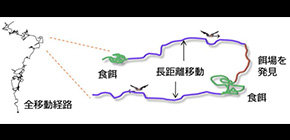
An AI technology to reveal the characteristics of animal behavior only from the trajectory
STEFTR: A hybrid versatile method for state estimation and feature extraction from the trajectory of animal behavior
Recording the movements of people and animals (including birds and insects) has become very easy because of the development of small and inexpensive GPS devices and video cameras. However, it is still difficult to infer what triggers such movements (for example, external stimuli and/or their mental processes) from the behavioral records.
In this study, Shuhei Yamazaki and colleagues have developed an artificial intelligence (AI) technology, first, to estimate an animal's behavioral state, such as "resting", "feeding", or "traveling", without human classification, and, next, to explore the characteristics of each behavioral state by comparing responses under different conditions, such as before and after experiencing a certain stimulus.
This method, termed STEFTR (state estimation and feature extraction of animal behavior), enabled the researchers to estimate the behavioral states of roundworms and penguins that move approximately 1 cm in 10 min in a petri dish and several kilometers in 1 day or more in the Antarctic Ocean, respectively, by analyzing them in exactly the same way. Notably, they achieved > 90% accuracy using only tens of animal trajectories, although traditionally researchers used prior knowledge of specialists about the animal's movement and/or millions of video images of animal behavior to train AI.
In the feature extraction, Yamazaki et al. revealed experience-dependent (i.e., "learning"-dependent) changes in specific behavioral aspects in worms and bats, and sexual pheromone-dependent changes in fruit flies. Moreover, they revealed changes in nerve activity that is linked to behavioral change in worms.
In conclusion, the STEFTR method may make it easy to infer “important places” for animal behavior, such as nests and feeding places that are usually difficult to find, using only trajectory data of wild animals. In addition, it may help discover important brain activities related to animal behavior, thereby contributing to the progress of basic brain science.

Figure 1. A workflow of the STEFTR method. Trajectory data of animals are used to calculate eight basic behavioral features, and are analyzed to estimate behavioral states (upper panels). From a behavioral state, behavioral features are comprehensively evaluated (lower panels). © Kotaro Kimura

Figure 2. AI analysis of movement. Conceptual drawing of "AI analysis of movement". © Kotaro Kimura
The article “STEFTR: A hybrid versatile method for state estimation and feature extraction from the trajectory of animal behavior” was published in the journal of Frontiers in Neuroscience at DOI: https://doi.org/10.3389/fnins.2019.00626 .
Related links
